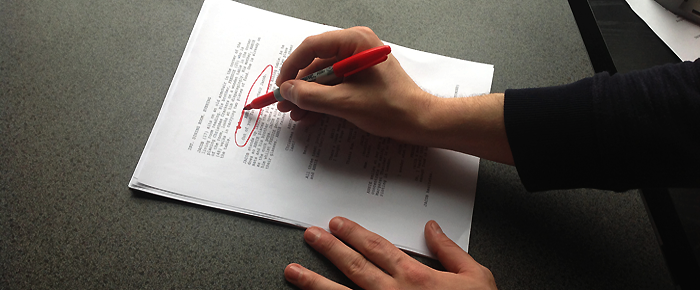
All the activities we pursue in our daily lives have directions. When you drive on the road there are laws meant to prevent us from getting into accidents, when we cook we follow a recipe and when we build with LEGOs we follow the literal directions so that our castles and spaceships turn out just right. For acting, the closest thing to a set of directions for how to proceed is a script. However, complications arise because of the different ways that readers interpret scripts. This means that the primary job of the actor is to analyze a script to uncover the truth about a character so they can accurately portray then on stage or on camera.
The First Read
Script analysis is a process and the process may be slightly different depending on the actor, but, in general, script analysis starts with the basics and gradually adds details. On the first read through, it is important to understand the literal situations and events that affect a character at each point in the story. These facts from the script are the given circumstances and help to determine the actions that you will take in performance.
As you read a script, make a list of all the facts about your character. Anything you can glean from a script is helpful. What do they do for a living? Where do they live? Who is closest to them?
Breakdown into Scenes and Beats
After you have a feel for the character, map out the story into scenes and beats. Good scripts are written as a series of related events where A leads to B and B to C and so on. The practice of making a scene map helps the actor to understand the story sequentially and provides built-in points to change action.
Look for points in the script where the setting changes or the characters on stage change, or time passes. These are common ways that scenes change. Beat changes are smaller shifts within the scenes where the characters may change their action, attitude, or topic of conversation. After identifying the scenes and beats….
Identify Your Characters’ Actions
Ask yourself, “What does my character want to other people in the scene to do?” The answer that question is your character’s objective. How are you going to accomplish your objective? That’s what is important because that gives you an action to play in each scene.
Usually, characters want other characters to do something, feel something, or understand something. For example, perhaps your character wants someone to get the mail. How will you get them to go to the mailbox for you? Charm them? Barter with them? Yell at them? The right action is the one that is true to your character and helps you to start identifying your character’s type.
Stay Open to Notes and Change
Remember that acting is a collaborative exercise and actors must also take a director’s opinion into account. Listen to what a director says and incorporate it into your character in an honest way, based on your own analysis of the script. Sometimes your initial analysis won’t be correct and you will have to make adjustments throughout the rehearsal process. But, with a strong foundation for your character, built from a thorough analysis of the script, these changes will be minor and your performance will be natural.
[su_note]Our Acting for Film workshops provide both aspiring and experienced actors with hands-on experience in acting in front of a camera. Taught by industry-leading instructors, our workshops span 1 to 12 weeks and are tailored to a variety of busy schedules. Visit our Acting for Film Workshops page to find one that suits your interests..[/su_note]
